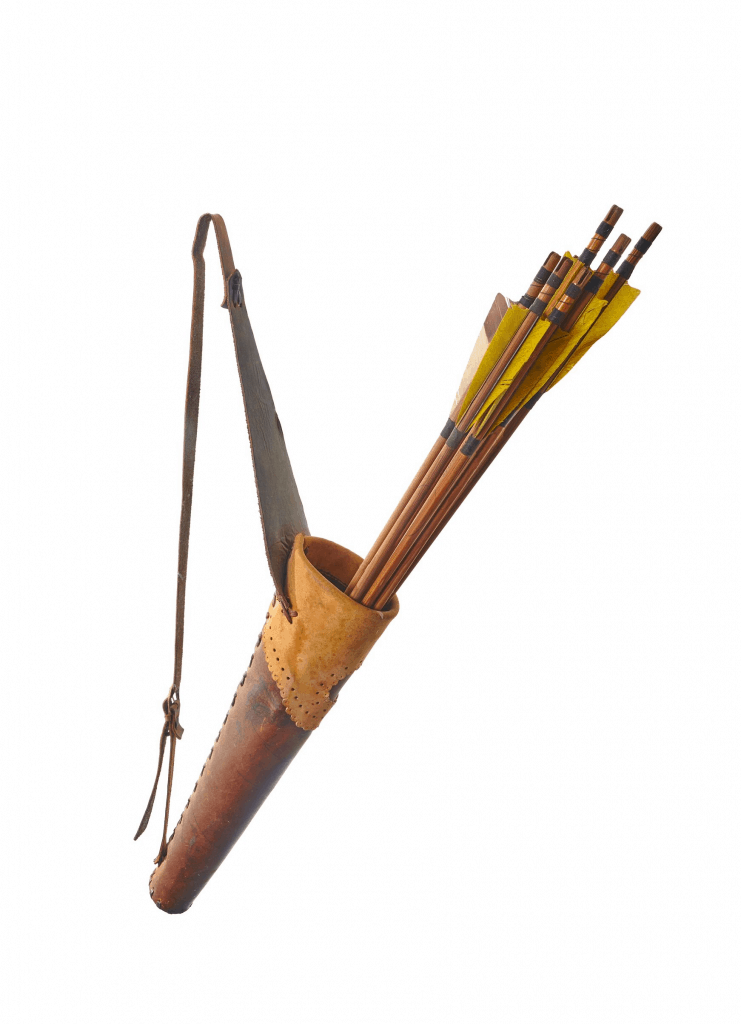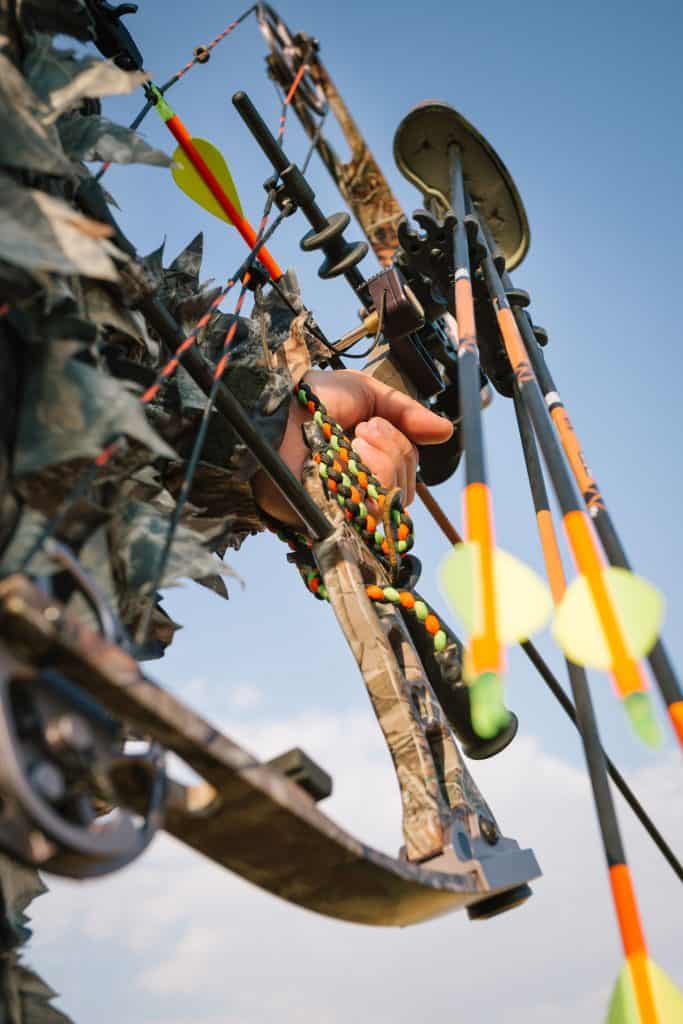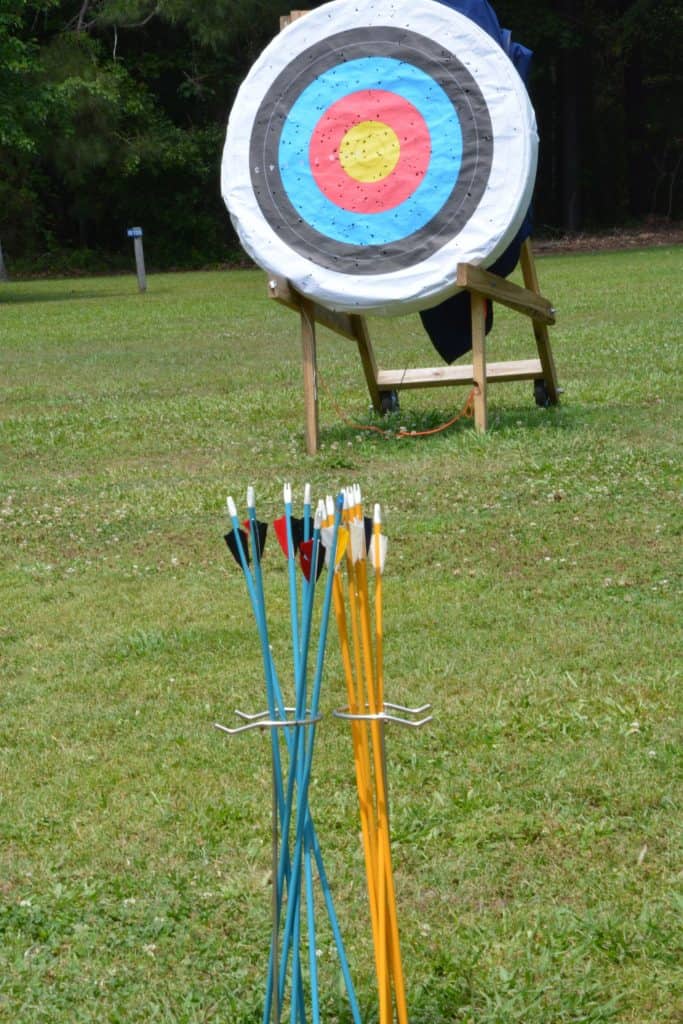
Technically, all you need to practice archery is a bow and a few arrows. But over the years, archers and intelligent minds have come together to improve the sport of archery by developing helpful accessories like the quiver.
An archery quiver is a cylindrical container designed to hold an archer’s arrows. Both bowhunters and target archers often use this accessory, which can be stored on the archer’s body, on his bow, or on the ground. Most quivers hold between three and twenty arrows.
For most archers, the quiver is one of the most important accessories in their gear bag, and it’s been around since the beginning of archery.
What is a Quiver?
The quiver is not a complicated device, but it does perform a very important function.
Archery would be much more difficult while trying to hold a dozen arrows in one hand, and laying the arrows on the ground is just not a good idea.
In order to avoid broken or lost arrows, archers of centuries past invented the quiver to hold their ammunition.
The quiver increases convenience as well as making transportation easier.
Though you may not have known what it was at the time, you’ve probably seen quivers in some of your favorite blockbuster movies.
For example, Legolas, an elf of the Woodland Realm and one of the main characters in J.R.R. Tolkien’s Lord of the Rings trilogy, can be seen using his quiver throughout the Lord of the Rings and even The Hobbit movies.
If you’re not a fan of medieval fantasy, you may have seen a quiver on Hawkeye’s back in The Avengers or one of the following movies in the Marvel franchise.
Both Orlando Bloom and Jeremy Renner were outfitted with quivers to complete their master archer ensemble, and even though they may have looked very different, they both achieved the main goal of a quiver, which is to store arrows in a secure place until the archer is ready to use them.
The different kinds of quivers have increased over time, making the quick identification of one a more complicated task.
What Kinds of Quivers are There?
There are many factors that go into determining what a quiver will look and feel like.
Some of those factors include position, material, and arrow count, which we’ll explore individually.
Position
The quiver can be designed to rest in one of a few different places.
Archer’s Body

One of the first places the quiver came to reside was the archer’s body itself.
Despite its limited representation in modern media, the belt quiver was the most common in the first days of the quiver.
Typically, these crudely-made containers were hung from a belt around the archer’s waist, providing quick access to the arrows.
Depending on the archer’s preference, belt quivers could be positioned to be at the side of the dominant hand or at the archer’s back.
Realistically, you could put them anywhere on the belt, but these were the most common places for the quiver to be attached.
Today, hip quivers are still popular, especially among traditional archers with longbows or recurve bows.
Both Hawkeye and Legolas are pictured using back quivers as opposed to hip quivers because let’s be honest, they just look cooler.
In reality, back quivers were not as popular as some movies set in medieval times make it seem, probably because they were less easily accessed than hip quivers.
The use of back quivers has been mostly traced back to Native American and African archers, though some modern archers do prefer this kind of quiver.
Bow Frame

Recently, the majority of quivers have moved from being on the archer’s body to being on the body of the bow itself.
This is most common with compound bows, which are usually designed to be used with several accessories.
These kinds of quivers attach to one side of the bow’s frame, so they are usually very light so as not to disrupt the balance of the bow too much.
Bow quivers usually look very different from the traditional Archer-bound quiver.
Rather than containing the bow within a cylindrical holder, bow quivers usually store arrows by enveloping either end with a stiff foam, leaving the main shaft exposed.
You will most often see bowhunters using bow quivers.
Ground Quiver

Ground quivers are often seen at archery ranges being used by target shooters, who don’t need to move positions.
In the past, they were used by combat archers, who typically remained in one spot, shooting at the enemy from behind their army’s defensive line.
These kinds of quivers can be designed either very simply or with great precision.
The simplest ground quivers are usually just stakes in the ground with a hoop attached at the top so that the arrows can’t fall over.
Fancier ground quivers hold the arrows with a more complicated and often more elegant design, sometimes even having a dispenser system to hold the arrows out to the archer so that they don’t have to bend down to reach them.
Material
In the past, quivers were made of common, natural materials such as leather, other animal skins and furs, and wood.
Today, man-made materials are typically used to construct these arrow containers, most often plastic or light metals.
Those who like to shoot with traditional equipment, however, can still find quivers made of stiff leather or other natural materials.
Arrow Count

The design of traditional quivers was less about quality and more about quantity, so they were usually made to hold as many arrows as possible without weighing the archer down too much.
Nowadays, most archers aren’t hunting to support their families or protect themselves, so fewer arrows are needed.
Bow and accessory weight is also a huge issue for most hunters, so quivers (especially bow quivers) are usually designed to carry no more than 10 or 12 arrows.
Some bow quivers even carry as few as three arrows.
For these kinds of quivers, the archer isn’t using them to carry all of his arrows, but rather the few he’ll realistically be able to fire off while shooting at one animal.
Ground quivers are typically designed to be able to hold more arrows, especially those found at a range, where archers can shoot as many arrows as they like.
The Best Quivers on the Market
If you’re looking into getting a quiver or just want to get a sense of the quivers on the market today, there is a lot of selection to go through.
To help you narrow it down, we’ll suggest a few best-sellers in each quiver category.

The Krayney 3-Tube Hip Quiver stands out among hip quivers for its reasonable price and efficient utility.
Most innovative about this hip quiver are the three tubes that arrows can be separated into.
This can be useful for sectioning off different kinds of arrows or just preserving their fletching.
There are also multiple fabric and mesh pockets to hold any other accessories you may need to bring with you.
With an adjustable width and two different color choices, this quiver can work for any archer.

The KRATARC Back Quiver is a well-made, reasonably-priced option for those interested in back quivers.
Like the Krayney hip quiver, this arrow container has several pockets and storage options in addition to the main arrow container.
The KRATARC back quiver can hold up to 24 arrows and is made of wear-resistant, heavy-duty polyester fabric.
This is ideal for the passionate, all-weather bowhunter who needs something just as tough as he is to hold his arrows.

Fans of traditional equipment may be interested in the TOPARCHERY Traditional Leather Back Quiver, which is made of three layers of genuine leather and black tarpaulin.

Target shooters would do well to purchase the Cannon Sports Ground Quiver, which has an extremely simple design but can be used to hold both a group of arrows and a bow.
Even if you are only one specific kind of archer, it might be a good investment to purchase one of each kind of quiver, rotating through them as need be.
Try out several quivers maybe one will be your next best quiver.
